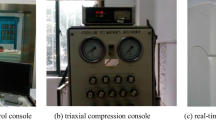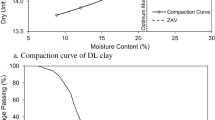Abstract
This paper presents a study in which triaxial tests were performed on loess soil reinforced with natural roots. Triaxial compression tests were performed on soil specimens with root biomass of 0.25, 0.5, 1.0, and 1.25% and subsequently consolidated at various confining stresses under drained and undrained conditions. The results are presented in terms of monotonic stress–strain behavior, volumetric behavior, failure envelope, and shear strength parameters. The test results showed that the inclusion of roots required higher confining stress to prevent failure. The reinforced specimen showed continued mobilization of dilatancy in drained and undrained conditions and resulted in exhibiting higher peak deviator stress compared to the unreinforced specimen. The specimen with the lowest root biomass exhibited the least increments in the hardening response, while the specimen with the largest root biomass showed the highest hardening response. The addition of roots decreased the contractancy of soil in both drained and undrained condition. Under the same root content and confining pressure, the shear strength in an undrained condition is much higher as compared to drained conditions. The largest improvement in soil's mechanical behavior was observed at smaller confining pressure, i.e., 100 kPa in both drained and undrained conditions. The addition of roots also increases the initial yielding of the soil, which is the function of roots biomass. The output of this research will provide a foundation for the future development of the predictive constitutive model for soil–root composite and its applications to slope stability.


















Similar content being viewed by others
References
Abe K, Ziemer RR (1991) Effect of tree roots on a shear zone: modeling reinforced shear stress. Can J For Res 21(7):1012–1019
Abernethy B, Rutherfurd ID (2001) The distribution and strength of riparian tree roots in relation to riverbank reinforcement. Hydrol Process 15(1):63–79
Ahmad F, Bateni F, Azmi M (2010) Performance evaluation of silty sand reinforced with fibres. Geotext Geomembr 28(1):93–99. https://doi.org/10.1016/j.geotexmem.2009.09.017
Airey D (1993) Triaxial testing of naturally cemented carbonate soil. J Geotech Eng 119(9):1379–1398
Ampadu S, Tatsuoka F (1993) Effect of setting method on the behaviour of clays in triaxial compression from saturation to undrained shear. Soils Found 33(2):14–34
Angers DA, Caron J (1998) Plant-induced changes in soil structure: processes and feedbacks. Biogeochemistry 42(1):55–72
Bischetti G, Bonfanti F, Greppi M (2003) Misura della resistenza alla trazione delle radici: apparato sperimentale e metodologia d’analisi. Quaderni di Idronomia Montana 21(1):349–360
Botero E, Ossa A, Sherwell G, Ovando-Shelley E (2015) Stress–strain behavior of a silty soil reinforced with polyethylene terephthalate (PET). Geotext Geomembr 43(4):363–369
Burroughs ER, Thomas BR (1977) Declining root strength in Douglas-fir after felling as a factor in slope stability, vol 190. Dept. of Agriculture, Forest Service, Intermountain Forest and Range
Capobianco V, Cascini L, Cuomo S, Foresta V (2020) Wetting-induced collapse behaviour of a natural and vegetated coarse pyroclastic soil
Cardoso R, Capobianco V, Cascini L, Cuomo S, Foresta V, Jommi C, Romero E (2020) Wetting-induced collapse behaviour of a natural and vegetated coarse pyroclastic soil. E3S Web Conf 195:03025. https://doi.org/10.1051/e3sconf/202019503025
Cascini L, Cuomo S, Pastor M, Sacco C (2013) Modelling the post-failure stage of rainfall-induced landslides of the flow type. Can Geotech J 50(9):924–934
Cascini L, Cuomo S, Pastor M, Sorbino G (2010) Modeling of rainfall-induced shallow landslides of the flow-type. J Geotech Geoenviron Eng 136(1):85–98
Cazzuffi D, Crippa E (2005) Shear strength behaviour of cohesive soils reinforced with vegetation. In: Proceedings of the international conference on soil mechanics and geotechnical engineering, vol 4. A.A. Balkema Publishers, p 2493
Chang M, Tang C, Zhang D-d, Ma G-c (2014) Debris flow susceptibility assessment using a probabilistic approach: a case study in the Longchi area, Sichuan province, China. J Mt Sci 11(4):1001–1014. https://doi.org/10.1007/s11629-013-2747-9
Chen X-z, Cui Y-f (2017) The formation of the Wulipo landslide and the resulting debris flow in Dujiangyan City, China. J Mt Sci 14(6):1100–1112
Chen C, Loehr J (2008) Undrained and drained triaxial tests of fiber-reinforced sand. In: Geosynthetics in civil and environmental engineering. Springer, pp 114–120
Chirico GB, Borga M, Tarolli P, Rigon R, Preti F (2013) Role of vegetation on slope stability under transient unsaturated conditions. Procedia Environ Sci 19:932–941
Consoli NC, Heineck KS, Casagrande MDT, Coop MR (2007) Shear strength behavior of fiber-reinforced sand considering triaxial tests under distinct stress paths. J Geotech Geoenviron Eng 133(11):1466–1469
Consoli N, Rotta G, Prietto P (2006) Yielding–compressibility–strength relationship for an artificially cemented soil cured under stress. Geotechnique 56(1):69–72
Conte E, Pugliese L, Troncone A (2020) Post-failure analysis of the Maierato landslide using the material point method. Eng Geol 277:105788
Dai F, Lee C, Wang S, Feng Y (1999) Stress–strain behaviour of a loosely compacted volcanic-derived soil and its significance to rainfall-induced fill slope failures. Eng Geol 53(3–4):359–370
Day RW (1993) Surficial slope failure: a case study. J Perform Constr Facil 7(4):264–269
Estabragh AR, Bordbar AT, Javadi AA (2012) A study on the mechanical behavior of a fiber-clay composite with natural fiber. Geotech Geol Eng 31(2):501–510. https://doi.org/10.1007/s10706-012-9602-6
Finér L, Helmisaari H-S, Lõhmus K, Majdi H, Brunner I, Børja I, Eldhuset T, Godbold D, Grebenc T, Konôpka B (2007) Variation in fine root biomass of three European tree species: Beech (Fagus sylvatica L.), Norway spruce (Picea abies L. Karst), and Scots pine (Pinus sylvestris L.). Plant Biosyst 141(3):394–405
Foresta V, Capobianco V, Cascini L (2020) Influence of grass roots on shear strength of pyroclastic soils. Can Geotech J 57(9):1320–1334
GB/T50123 Standard for Soil Test Method. Ministry of Construction, PR China (in Chinese)
Haeri S, Noorzad R, Oskoorouchi A (2000) Effect of geotextile reinforcement on the mechanical behavior of sand. Geotext Geomembr 18(6):385–402
Hu X-s, Brierley G, Zhu H-l, Li G-r, Fu J-t, Mao X-q, Yu Q-q, Qiao N (2013) An exploratory analysis of vegetation strategies to reduce shallow landslide activity on loess Hillslopes, Northeast Qinghai-Tibet Plateau, China. J Mt Sci 10(4):668–686. https://doi.org/10.1007/s11629-013-2584-x
Jia L, Guo J, Jiang Y, Fu Y, Zhou Z, Lim SM, Zhao X (2019) Experimental investigation on shear strength parameters of lime stabilized loess. Sustainability 11(19):5397. https://doi.org/10.3390/su11195397
Leung AK, Garg A, Ng CWW (2015) Effects of plant roots on soil-water retention and induced suction in vegetated soil. Eng Geol 193:183–197. https://doi.org/10.1016/j.enggeo.2015.04.017
Li C (2005) Mechanical response of fiber-reinforced soil. PhD Dissertation, The University of Texas at Austin
Lian B, Peng J, Zhan H, Cui X (2019) Effect of randomly distributed fibre on triaxial shear behavior of loess. Bull Eng Geol Environ 1–9
Lian B, Peng J, Zhan H, Wang X (2019) Mechanical response of root-reinforced loess with various water contents. Soil Tillage Res 193:85–94. https://doi.org/10.1016/j.still.2019.05.025
Liu KF, Yang XR, **e XY, Wu CF, Liu YH (2011) Laboratory triaxial test study on soil reinforced with roots of Manilagrass. Advanced Materials Research. Trans Tech Publ, pp 1366–1370
Margottini C, Spizzichino D (2010) Climate change, geological and hydrological hazard and adaptation policy in Italy. Paper presented at the EGU General Assembly 2010, Vienna, Austria, May 01, 2010
McGuire B, Maslin MA (2012) Climate forcing of geological hazards. Wiley
Mehtab A, Jiang Y-J, Su L-J, Shamsher S, Li J-J, Mahfuzur R (2020) Scaling the roots mechanical reinforcement in plantation of Cunninghamia R. Br Southwest China For 12(1):33. https://doi.org/10.3390/f12010033
Mehtab A, Jiang Y-j, SU L-j, Shamsher S, Li J-J, Mahfuzur R (2021) Effects of root orientation on the strength characteristics of loess in drained and undrained triaxial tests. Eng Geol (submitted)
Monteleone S, Sabatino M (2014) Hydrogeological hazards and weather events: Triggering and evolution of shallow landslides. Int Soil Water Conserv Res 2(2):23–29
Muir Wood D (2004) Experimental inspiration for kinematic hardening soil models. J Eng Mech 130(6):656–664
Ng CWW, Leung AK (2012) Measurements of drying and wetting permeability functions using a new stress-controllable soil column. J Geotech Geoenviron Eng 138(1):58–68
Ng C, Menzies B (2007) Advanced unsaturated soil mechanics and engineering. Taylor & Franci, New York
Ng CWW, Ni J, Leung AK, Zhou C, Wang Z (2016) Effects of planting density on tree growth and induced soil suction. Géotechnique 66(9):711–724
Ng CWW, Tasnim R, Capobianco V, Coo JL (2018) Influence of soil nutrients on plant characteristics and soil hydrological responses. Geotech Lett 8(1):19–24
Ni J, Leung AK, Ng CWW, Shao W (2018) Modelling hydro-mechanical reinforcements of plants to slope stability. Comput Geotech 95:99–109
Nilaweera NS, Nutalaya P (1999) Role of tree roots in slope stabilisation. Bull Eng Geol Env 57(4):337–342
Operstein V, Frydman S (2000) The influence of vegetation on soil strength. Proc Inst Civ Eng-Ground Improv 4(2):81–89
Pan Y, Liu Y, **ao H, Lee FH, Phoon KK (2018) Effect of spatial variability on short-and long-term behaviour of axially-loaded cement-admixed marine clay column. Comput Geotech 94:150–168
Pollen N (2007) Temporal and spatial variability in root reinforcement of streambanks: accounting for soil shear strength and moisture. CATENA 69(3):197–205. https://doi.org/10.1016/j.catena.2006.05.004
Rotta G, Consoli N, Prietto P, Coop M, Graham J (2003) Isotropic yielding in an artificially cemented soil cured under stress. Geotechnique 53(5):493–501
Simon A, Collison AJC (2002) Quantifying the mechanical and hydrologic effects of riparian vegetation on streambank stability. Earth Surf Proc Land 27(5):527–546. https://doi.org/10.1002/esp.325
Smith P, Jardine R, Hight D (1992) The yielding of Bothkennar clay. Géotechnique 42(2):257–274
Stokes A, Atger C, Bengough AG, Fourcaud T, Sidle RC (2009) Desirable plant root traits for protecting natural and engineered slopes against landslides. Plant Soil 324(1–2):1–30. https://doi.org/10.1007/s11104-009-0159-y
Stokes A, Lucas A, Jouneau L (2007) Plant biomechanical strategies in response to frequent disturbance: uprooting of Phyllostachys nidularia (Poaceae) growing on landslide-prone slopes in Sichuan, China. Am J Bot 94(7):1129–1136
Świtała BM, Wu W (2018) Numerical modelling of rainfall-induced instability of vegetated slopes. Géotechnique 68(6):481–491. https://doi.org/10.1680/jgeot.16.P.176
Testing ASf, Soil MCDo, Rock (2004) Standard test methods for particle-size distribution (gradation) of soils using sieve analysis. ASTM International
Traoré O, Groleau-Renaud V, Plantureux S, Tubeileh A, Boeuf-Tremblay V (2000) Effect of root mucilage and modelled root exudates on soil structure. Eur J Soil Sci 51(4):575–581
Verma KS, Kohli S, Kaushal R, Chaturvedi OP (2014) Root structure, distribution and biomass in five multipurpose tree species of Western Himalayas. J Mt Sci 11(2):519–525
Waldron LJ (1977) The shear resistance of root-permeated homogeneous and stratified soil1. J Soil Sci Soc Am 41(5):843–849
Waldron L, Dakessian S, Nemson J (1983) Shear resistance enhancement of 1.22-meter diameter soil cross sections by pine and alfalfa roots. Soil Sci Soc Am J 47(1):9–14
Wu TH (2013) Root reinforcement of soil: review of analytical models, test results, and applications to design. Can Geotech J 50(3):259–274
Wu TH, McKinnell WP III, Swanston DN (1979) Strength of tree roots and landslides on Prince of Wales Island. Alaska Can Geotech J 16(1):19–33
**ao H, Lee FH, Chin KG (2014) Yielding of cement-treated marine clay. Soils Found 54(3):488–501
Yildiz A, Graf F, Rickli C, Springman SM (2018) Determination of the shearing behaviour of root-permeated soils with a large-scale direct shear apparatus. CATENA 166:98–113
Zhang C-B, Chen L-H, Liu Y-P, Ji X-D, Liu X-P (2010) Triaxial compression test of soil–root composites to evaluate influence of roots on soil shear strength. Ecol Eng 36(1):19–26. https://doi.org/10.1016/j.ecoleng.2009.09.005
Zhang B, Zhang S, Zhou W (2006) Investigation and assessment of landslides and debris flows in Sichuan province of China by remote sensing technique. Chin Geogra Sci 16(3):223–228
Acknowledgements
This research work was supported by the Strategic Priority Research Program of the Chinese Academy of Sciences [XDA23090202] and the National Natural Science Foundation of China (Grant No. 42172320). The authors acknowledge the Chinese Academy of Sciences Pioneer Hundred Talents Program.
Author information
Authors and Affiliations
Corresponding author
Ethics declarations
Conflicts of interest
The authors declare no conflicts of interest regarding the publication of this paper.
Additional information
Publisher's Note
Springer Nature remains neutral with regard to jurisdictional claims in published maps and institutional affiliations.
Rights and permissions
About this article
Cite this article
Alam, M., Jiang, YJ., Umar, M. et al. Influence of drainage and root biomass on soil mechanical behavior in triaxial tests. Acta Geotech. 17, 2875–2893 (2022). https://doi.org/10.1007/s11440-021-01380-w
Received:
Accepted:
Published:
Issue Date:
DOI: https://doi.org/10.1007/s11440-021-01380-w




